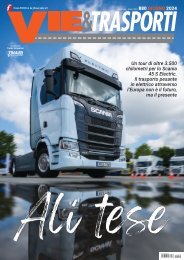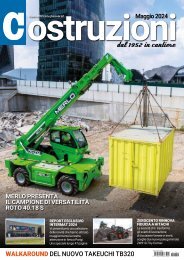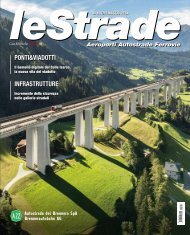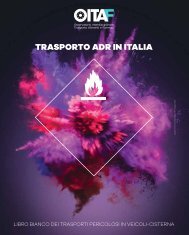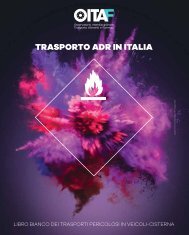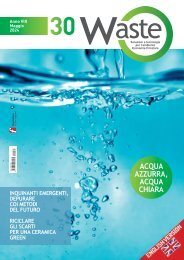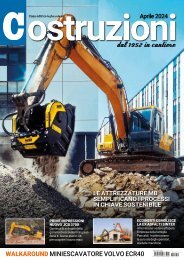leStrade n. 1956 aprile 2024
INFRASTRUTTURE Milano Serravalle Milano Tangenziali La sicurezza in tempo reale GALLERIE La Realtà Virtuale “avanza” nelle gallerie BBT
INFRASTRUTTURE
Milano Serravalle Milano Tangenziali La sicurezza in tempo reale
GALLERIE
La Realtà Virtuale “avanza” nelle gallerie BBT
- No tags were found...
You also want an ePaper? Increase the reach of your titles
YUMPU automatically turns print PDFs into web optimized ePapers that Google loves.
L’autoparco di Rovereto Sud<br />
sarà certificato a breve.<br />
Totale attenzione alla sicurezza<br />
Nel frattempo Autostrada del Brennero continua<br />
a mantenere alta l’attenzione in tutti quei settori<br />
che presentino margini di miglioramento per la<br />
sicurezza di chi viaggia. L’implementazione delle<br />
aree di parcheggio sicure e protette (Safe and<br />
Secure Truck Parking Areas – SSTPA) ad esempio<br />
è stata identificata da diversi anni come una delle<br />
risposte più efficaci per affrontare il problema<br />
della sicurezza stradale, per migliorare la sicurezdi<br />
conseguenza l’incidentalità e l’impatto emissivo<br />
sull’ambiente.<br />
Con C-Roads Italy Autostrada del Brennero ha<br />
sviluppato e implementato tutta l’infrastruttura<br />
di base: ha scritto le specifiche, creato un server<br />
C-ITS e dotato l’arteria di Rsu fisse – oggi di<br />
queste speciali antenne lungo l’A22 se ne contano<br />
68 – e di una RSU virtuale per la comunicazione<br />
a lungo raggio, ossia su rete cellulare (4G<br />
o in futuro 5G) per arrivare anche laddove non<br />
arriva il wifi. Sempre nell’ambito di C-Roads Italy<br />
sono state testate funzionalità di guida come l’Highway<br />
Chauffeur o il Truck Platooning, che ha<br />
visto un convoglio di tir guidato solo dal primo<br />
veicolo (anche se i conducenti erano sempre presenti<br />
su tutti i camion) percorrere 300mila chilometri<br />
muovendosi in sicurezza nel traffico ed è<br />
stata sperimentata con successo l’interoperabilità<br />
del sistema attraverso il confine del Brennero.<br />
Durante C-Roads Italy 3 Autobrennero ha acquistato<br />
cinque RSU fisse e 15 mobili, che saranno<br />
in seguito installate su mezzi dei Centri per la Sicurezza<br />
Autostradali che operano nei cantieri e<br />
laddove si verifichino emergenze e sui mezzi invernali.<br />
I casi d’uso mobili hanno rappresentato<br />
il fulcro del progetto sviluppato dall’A22 in C-Roads<br />
Italy 3: l’attenzione si è focalizzata sulla comunicazione<br />
tra arteria e veicoli che si muovevano<br />
a velocità anomale, o particolarmente lenti<br />
perché attivi in un cantiere o particolarmente veloci,<br />
come i mezzi di soccorso.<br />
re questa via già da anni, aderendo e capitanando<br />
numerosi progetti di ricerca internazionali nel<br />
settore, fra cui C-Roads Italy, coordinato dal Mit<br />
e co-finanziato dalla Commissione europea. La<br />
terza edizione si è conclusa a dicembre e ha visto<br />
Autobrennero implementare e arricchire il lavoro<br />
fatto con C-Roads Italy. Il progetto aveva fin<br />
dall’inizio l’obiettivo di studiare e testare quindi in<br />
condizioni reali di traffico i sistemi C-ITS (Cooperative<br />
Intelligent Transport Systems). Una rivoluzione<br />
copernicana nella gestione del traffico: il<br />
rapporto univoco tra centro di controllo, nel caso<br />
di A22 il CAU (Centro Assistenza Utenza), che invia<br />
informazioni in particolare ai pannelli a messaggio<br />
variabile, viene gradualmente affiancato<br />
da un’infrastruttura C-ITS che consente una<br />
comunicazione in primis tra infrastruttura e veicolo<br />
(I2V), ma anche tra veicolo e infrastruttura<br />
(V2I). L’asse attorno cui ruota questa importante<br />
trasformazione è la georeferenziazione. Ossia<br />
le informazioni che veicoli e arteria si scambiano,<br />
a differenza del passato, sono costantemente<br />
aggiornate e geolocalizzate, con una mappatura<br />
dell’intera arteria in tempo reale. Gli effetti<br />
positivi attesi sono molteplici: conoscere, in ogni<br />
istante, la velocità dei veicoli in marcia, le condizioni<br />
del traffico in ogni punto della tratta, il volume<br />
di auto e automezzi presenti, consente di regolare<br />
i flussi di traffico e le velocità, aumentando<br />
la capacità autostradale, riducendo gli stop&go e<br />
Una delle 68 RSU installate<br />
lungo l’Autobrennero.<br />
English Version<br />
road with fixed RSUs - today there are 68 of these special<br />
antennas along the A22 - as well as a virtual RSU<br />
for long-range communication, i.e. on a cell network<br />
(4G or in the future 5G) which can get to places even<br />
wifi cannot cover. C-Roads Italy has also tested driving<br />
functions such as Highway Chauffeur and Truck Platooning.<br />
The latter saw a convoy of trucks driven only by<br />
the first vehicle (although drivers were always present<br />
on all trucks) cover 300,000 kilometres safely, interacting<br />
with Stellantis connected vehicles, and successfully<br />
testing the interoperability of the system across<br />
the Brenner border. In C-Roads Italy 3 Autobrennero<br />
purchased five fixed and 15 mobile RSUs, which will later<br />
be installed on the Motorway Safety Centres’ vehicles,<br />
which operate at construction sites and where<br />
emergencies occur, and on winter vehicles. Mobile use<br />
cases were the core of the project developed by the<br />
A22 in C-Roads Italy 3: the focus was on communication<br />
between the road and vehicles moving at abnormal<br />
speeds, either particularly slow because they were on<br />
a construction site or particularly fast, such as emergency<br />
vehicles. In the meantime, the Brenner Motorway<br />
continues to shine a spotlight on all those areas where<br />
there is room for traveller-safety improvement. For<br />
example, the implementation of Safe and Secure Truck<br />
Parking Areas (SSTPA) has been identified as one of<br />
the most effective responses to road safety challenges<br />
for several years, with a view to improving the safety of<br />
road transport vehicles and the working conditions of<br />
truck drivers and logistics operators. There are 22 servi-<br />
ce areas on the A22, 11 on the northbound carriageway<br />
and 11 on the southbound carriageway, plus the Plessi<br />
Museum. There are 10 parking areas available to heavy<br />
goods vehicles. But it is difficult for hauliers potentially<br />
setting off from the Czech Republic, for example, and<br />
travelling to Spain via several countries and regions, to<br />
know the characteristics of each section. Being able to<br />
plan their journeys and stops would certainly impact<br />
positively on driver’s safety and peace of mind, both for<br />
themselves and for the goods transported. For this reason,<br />
Autostrada del Brennero has decided to act as coordinator<br />
in European call for tenders CEF-T-2021-SA-<br />
FEMOBGEN, proposing the PASS4CORE-ITA 2 project<br />
and thus answering to the Ministry of Infrastructure<br />
and Transport (MIT) for its proper implementation. The<br />
aim of the project is to develop a network of safe and<br />
secure parking areas for heavy vehicles along the Italian<br />
TEN-T road network, areas to be built to the highest<br />
Infrastrutture&Mobilità<br />
62 4/<strong>2024</strong> <strong>leStrade</strong><br />
<strong>leStrade</strong> 4/<strong>2024</strong> 63






